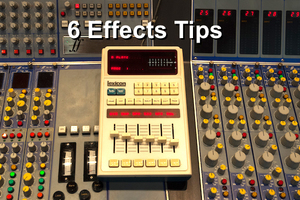- in Book Excerpt , Engineering by Bobby Owsinski
6 Tips For Adding Effects To A Mix
 One of the reasons why we record elements in stereo is to capture the natural ambience of an instrument. Because we can’t always record everything this way, we must create this aural space artificially, and that can be a problem for some new to mixing. There are so many choices and variables available with effects these days that things can get confusing, but these 6 tips that can help you choose what you need for each track more efficiently, courtesy of the 4th edition of The Mixing Engineer’s Handbook.
One of the reasons why we record elements in stereo is to capture the natural ambience of an instrument. Because we can’t always record everything this way, we must create this aural space artificially, and that can be a problem for some new to mixing. There are so many choices and variables available with effects these days that things can get confusing, but these 6 tips that can help you choose what you need for each track more efficiently, courtesy of the 4th edition of The Mixing Engineer’s Handbook.
Tip #1 – Picture The Performer In An Acoustic Space And Then Realistically Recreate That Space Around Them. This method usually saves some time over simply experimenting with different effects presets until something excites you (although that method can work too). Also, the created acoustic space needn’t be a natural one. In fact, as long as it fits the music, the more creative the better.
Tip #2 – Smaller Reverbs Or Short Delays Make Things Sound Bigger. Reverbs with decays under a second (and usually much shorter than that) and delays under 100 milliseconds (again, usually a lot shorter than that) tend to make the track sound bigger rather than push it back in the mix, especially if the reverb or delay is in stereo.
Many times a reverb will be used with the decay parameter turned down as far as it will go (which may be as low as 0.1 seconds), but this setting is sometimes the most difficult for a digital reverb to reproduce, resulting in a metallic sound. If this occurs, sometimes lengthening the decay time a little or trying a different preset will result in a smoother, less tinny sound, or you can try another plugin or hardware unit that performs better under these conditions.
Tip #3 – Long Delays, Reverb Predelays, Or Reverb Decay Push A Sound Farther Away If The Level Of The Effect Is Loud Enough. As stated before, delays and predelays longer than 100 ms are distinctly heard and begin to push the sound away from the listener. The trick between something sounding big or just distant is the level of the effect. When the decay or delay is short and the level loud, the track sounds big. When the decay or delay is long and loud, the track just sounds far away.
Tip #4 – If Delays Are Timed To The Tempo Of The Track, They Add Depth Without Being Noticeable. Most mixers set the delay time to the tempo of the track. This makes the delay pulse with the music and adds a reverb type of environment to the sound. It also makes the delay seem to disappear as a discrete repeat but still adds a smoothing quality to the element.
Tip #5 – If Delays Are Not Timed To The Tempo Of The Track, They Stick Out. Sometimes you want to distinctly hear a delay and the best way to do that is to make sure that the delay is NOT exactly timed to the track. Start by first putting the delay in time with the track, then slowly alter the timing until the desired effect is achieved.
Tip #6 – Reverbs Sound Smoother When Timed To The Tempo Of The Track. Reverbs are timed to the track by triggering them off of a snare hit and adjusting the decay parameter so that the decay just dies by the next snare hit. The idea is to make the decay “breathe” with the track. One way to achieve this is to make everything as big as possible at the shortest setting first, then gradually get longer until it’s in time with the track.
Of course, the biggest part of adding effects to a mix is experience, but following these tips will provide a perfect place to start.
To read additional excerpts from The Mixing Engineer’s Handbook and my other books, go to the excerpts section of bobbyowsinski.com.

